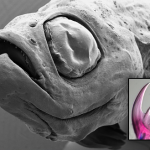
The sea cucumber, Scotoplanes globosa, at 1500m in Monterey Canyon.
Just Science Entry #4
Not giant squid or man eating sharks…megafauna, those organisms those organisms large enough to be caught in trawls or seen in photographs or video. (fish, crabs, lobsters, starfish, urchins, sea cucumbers, sponges, corals, etc.). This is different than the macrofauna (those organisms retained on a small screen mesh sieve, cannot see them with the naked eye) and meiofauna (really small organisms you cannot see with the naked eye like forams, copepods, nematodes).
For more than a century the ocean depths were assumed to be sterile of life. That’s 3/4 of earth’s surface with no life. These ideas are largely traceable to Edward Forbes, a crazy Victorian, in the late 1800’s, who proposed this azoic hypothesis. Ironically, the hypothesis was largely based on samples from the Aegean Sea now known to have relatively low densities of organisms compared to other deep-sea areas (so he was right and wrong). The lack of deep-sea life was overturned by several later reports of deep-sea species attached to sounding lines and the dredging cruises of the H.M.S. Lighting, Porcupine, and Challenger. In 1968, Sander’s work indicated that deep-sea diversity exceeded coastal diversity in the temperate zone and approached shallow-water tropical diversity. The development and deployment of more effective sampling gear has indicated that diversity is probably even higher than Sanders estimated, potentially rivaling that of tropical rain forests. Move over Amazonian Rainforest…here comes the murky depths! This great diversity in what appears to be a homogeneous environment has been a stumbling block for modern science. A multitude of potentially interacting factors has been proposed to influence species diversity in the deep sea including food limitation, current flow strength, bottom-water oxygen concentration, sediment heterogeneity, and biotic disturbance.
Megafauna comprise a significant component of deep-sea biodiversity with their total biomass often exceeding that of other faunal components like macrofauna or meiofauna. Given the prominence of the megafauna, their effect on the biodiversity of macrofauna and meiofauna are expected to be sizeable (bad day to be a small). Megafauna through disturbing the habitat (home wreckers), predation (lunch!), competition for shared food resources (you weren’t eating that were you), or producing structures (construction zone) like reefs or mounds could either enhance or suppress macrofaunal diversity.
Megafauna as home wreckers-Through reworking of the sediment by normal activities burrowing, feeding on the sediment (deposit feeding), crawling, etc. it disturb macrofaunal species. Megafaunal processing of sediments through ingestion has been estimated to by one study to be 100 g of sediment per day and in another 1500 ml of sediment per meter squared per year.
Megafauna as voracious predators–Predation may reduce macrofaunal densities and prevented species from competitively excluding each other (Gaussian Competitive Exclusion Principle). However, the dominance of deposit feeders and scavengers among mobile megafauna has generated skepticism of this hypothesis. Nevertheless, experimental evidence demonstrates the integral role of predation at hydrothermal vents and mud communities.
Megafauna as stingy eaters-Large mobile fauna may also influence macrofauna and meiofauna through competition for a limited food resource. For example, sea cucumbers display a large morphological range in tentacle type and thus vie for a large variety of organic particle sizes. In situ observations of holothurian movements over the seabed and effective capture area of each tentacle indicates that the impact on the quality of food available for macro- and meiofauna can be major.
Megafauna as builders-Sessile and mobile megafauna may influence biodiversity by creating new habitats. Enteropneusts can produce spiral fecal trails with an area of 0.1 meter squared in less than 40 hours. These biogenic structures can provide potential refuge from predation and control flow dynamics on the seafloor that impact other organisms.






Why does that location of the Aegean have such low densities?
My guess is low overhead production, so less food flux into the deep sea.